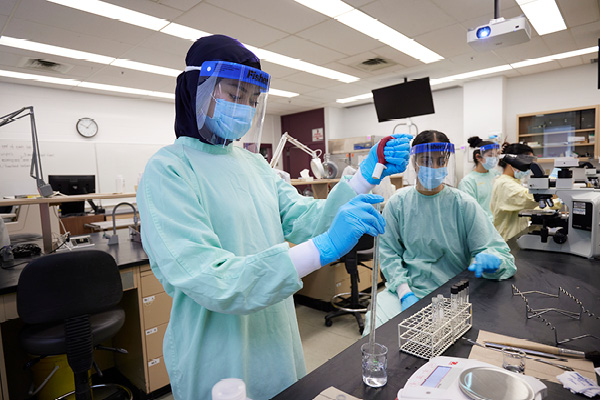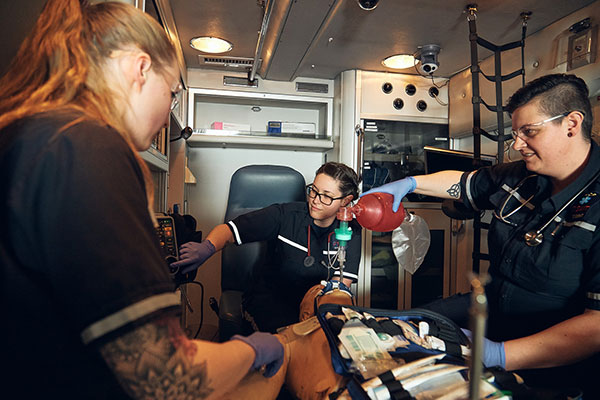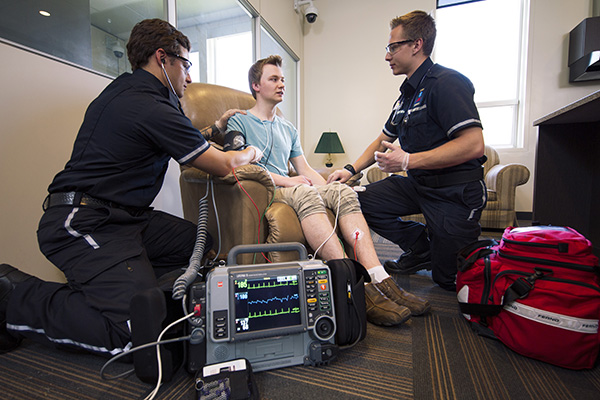Funding increases training capacity for medical programs

Note-taking apps and online textbooks have lightened the load in student backpacks, and information is more accessible than ever before. Virtual presentation and collaboration software have made classroom walls more flexible. Technology is already facilitating learning — and here’s one way it’s boosting access to real-world training scenarios for students in two of SAIT’s School of Health and Public Safety programs.
SAIT, as a member of Colleges and Institutes Canada (CICan), participated in the development of a content library for virtual simulation training in four areas of healthcare programming: nursing, medical laboratory technology, paramedicine and sonography. Employment and Social Development Canada (ESDC) provided the funding for the virtual work-integrated learning program, named the Virtu-WIL Program, which seeks to increase access and availability of this type of training for healthcare education.
The Medical Laboratory Technology (MLT) is a long-standing SAIT program that has been training students for 55 years and involves the analysis of patient samples such as blood, urine and tissues to help diagnose, treat and monitor diseases. As much as 70% of diagnostic testing is performed by a medical laboratory technologist, including COVID-19 tests needed during the pandemic.
“The program maximizes opportunities for students to learn critical skills, while addressing limited practicum spaces and expanding availability in remote areas.,” says Sonja Chamberlin, Dean, SAIT School of Health and Public Safety. “Virtu-WIL increases accessibility and allows more graduates to enter the workforce.”
Maximizing time in the lab

Institutions Canada-wide participated in the development of the content library, and the program was delivered to more than 2,000 students in phase one. SAIT created three of the 36 simulations for MLT.
There are five disciplines in MLT: histology, hematology, microbiology, chemistry and transfusion medicine. “For microbiology, which is my specialty area, we created an exercise to process a throat swab to go through the agar media and incubation depending on the specimen,” says Lori Cucheron, instructor in the MLT program.
Validating simulations at other post-secondary institutions was also a key step in the program’s success. SAIT MLT students completed and provided feedback on simulations created at other institutions across Canada, ensuring quality of the final training product.
Expanding the scenarios for paramedic students

Particularly important in the Advanced Care Paramedic program is exposure to complex or rare events and high-risk procedures.
Jimmy Joy, interim Academic Chair, Life Sciences, says the Virtu-WIL program allows students to practice skills for scenarios they likely wouldn’t see over the course of their practicums. “There are some events that need significant intervention, but don't happen frequently. We refer to these as HALO skills, high acuity and low occurrence skills, where a student will need to exercise what’s commonly known as essential or soft skills on top of their paramedic-specific training.”
Phase two of the Virtu-WIL project will see 50 new simulations created and delivered to an additional 3,000 students. Already, students are benefiting from the simulations by getting a sense of what a real day would be like in their field.
“The simulations gave me the opportunity to see our practice in a different way, not so much learning new information but putting my current knowledge to work,” says Jasmin Salmon, Advanced Care Paramedic student.
Make a difference with a career in healthcare
Whether you focus on pre-hospital care as a paramedic or perform diagnostic laboratory tests as a medical lab technologist, play a vital role on a large team. Explore hands-on training health and medical program options at SAIT.

Medical Laboratory Technology
-
Diploma
- Program Length: 2 years
- Campus: Blended (Main Campus and Online)
- Faculty: School of Health and Public Safety

Advanced Care Paramedic
-
Diploma
- Program Length: 2 years
- Campus: In person (Main Campus) or Blended (Main Campus and Online)
- Faculty: School of Health and Public Safety

Primary Care Paramedic
-
Certificate
- Program Length: 40 weeks
- Campus: In person (Main Campus) or Blended (Main Campus and Online)
- Faculty: School of Health and Public Safety
Skills for the Future
We prepare students for successful careers and lives.
SAIT'S
2020-2025
Strategic plan

Oki, Âba wathtech, Danit'ada, Tawnshi, Hello.
SAIT is located on the traditional territories of the Niitsitapi (Blackfoot) and the people of Treaty 7 which includes the Siksika, the Piikani, the Kainai, the Tsuut’ina and the Îyârhe Nakoda of Bearspaw, Chiniki and Goodstoney.
We are situated in an area the Blackfoot tribes traditionally called Moh’kinsstis, where the Bow River meets the Elbow River. We now call it the city of Calgary, which is also home to the Métis Nation of Alberta.